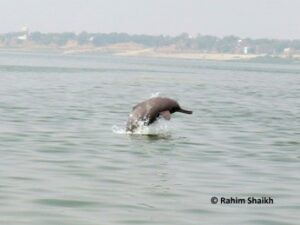Published on: October 19, 2023
Ganges River Dolphin
Ganges River Dolphin
Why in news? Uttar Pradesh has declared the Gangetic Dolphin as the state aquatic animal
Highlights:
- The Ganges dolphin is already recognized as the national aquatic animal and state animal of Assam
- These dolphins are found in rivers like Ganga, Yamuna, Chambal, Ghaghra, Rapti, and Gerua.
- Under Meri Ganga Meri Dolphin 2023 campaign, counting of dolphins is being done in river Ganga from near Muzaffarpur Barrage to the entire Narora Barrage by WWF and Forest Department teams.
About Gangetic Dolphin
Habitat
- Lives along the Ganges-Brahmaputra-Meghna and Karnaphuli-Sangu river systems of Bangladesh and India, and the Sapta Koshi and Karnali Rivers in Nepal.
Features
- It can only live in freshwater, essentially blind and estimated to live up to 30 years old.
- The gestation period is 9-11 months and a female gives birth to only one calf, once in 2-3 years.
- Ganges river dolphin cannot breathe in water and must surface every 30-120 seconds and because of the sound it produces when breathing, the animal is popularly referred to as ‘Susu’.
- Females tend to be larger than males
- They have a large melon head used for echolocation, because they cannot see well and hunt by emitting ultrasonic sounds waves that bounce off of fish and other prey
- Its presence indicates a healthy river ecosystem, and considered an indicator species
Protection
- IUCN status: Endangered
- Indian Wildlife (Protection) Act 1972 : Schedule I
- It is in Appendix I of CITES
Conservation
- Ministry of Environment and Forest declared the Gangetic dolphin the national aquatic animal of India.
- The first protected area called Vikramshila Gangetic Dolphin Sanctuary was established at Bihar
- Ministry of Environment, Forest and Climate Change announced ‘Project Dolphin’ to boost conservation of both river and oceanic dolphins.

